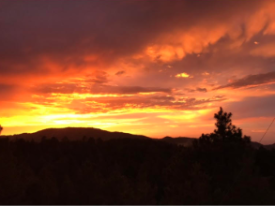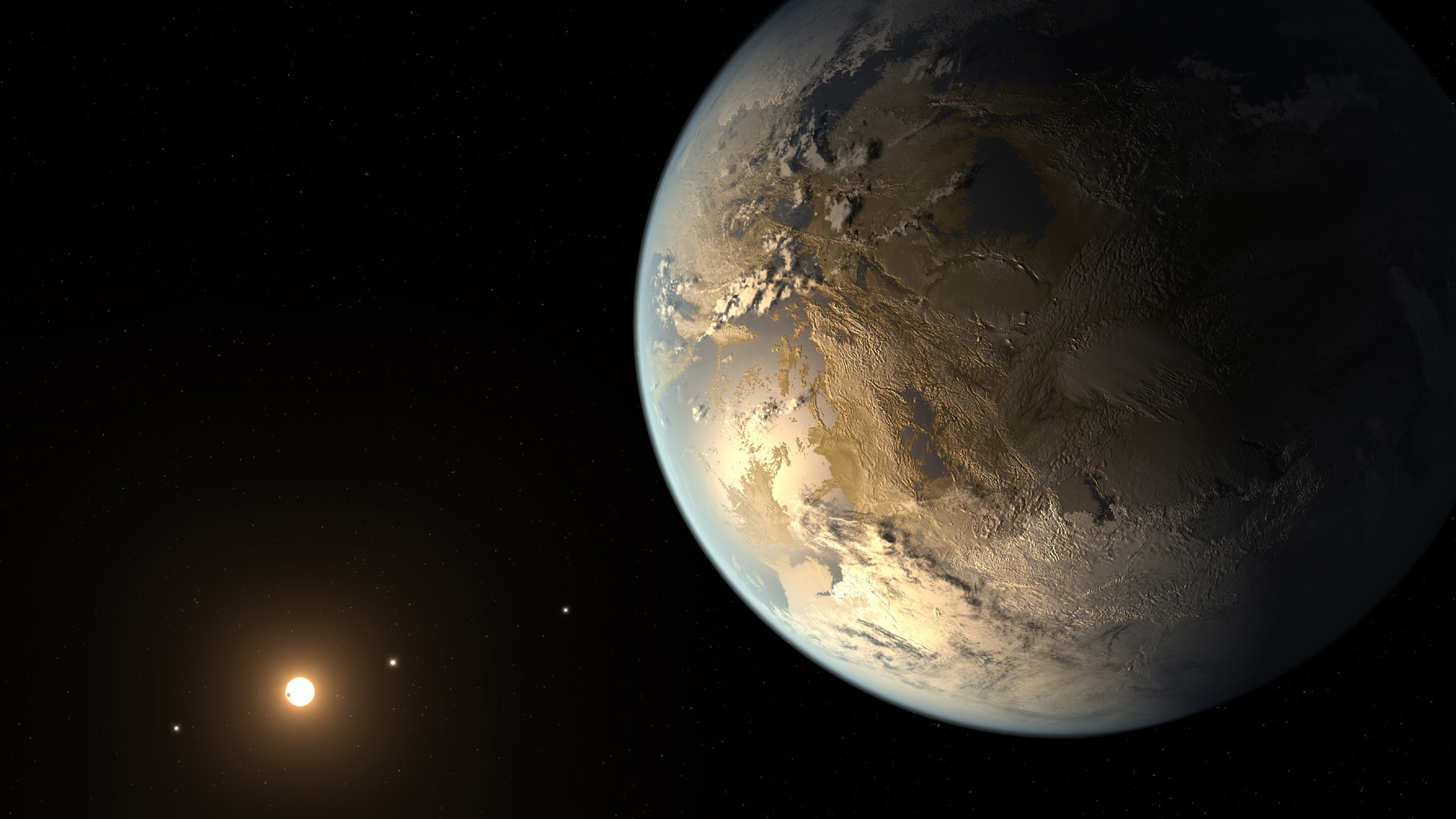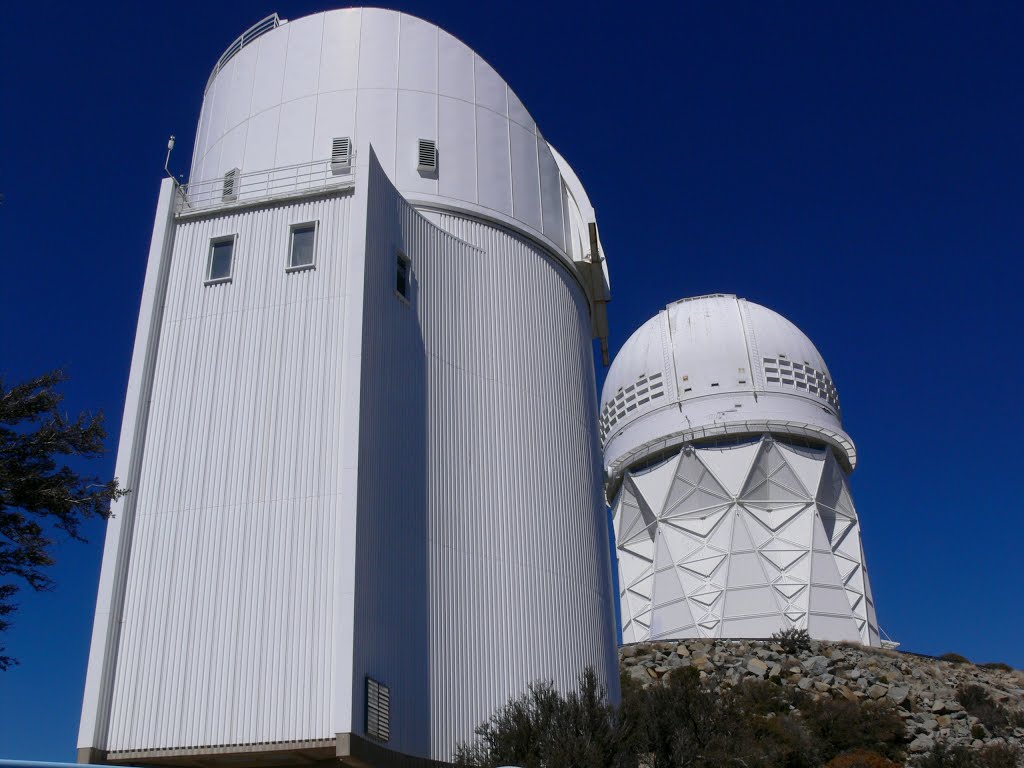Anyone who lives in Tucson will tell you ‘watch out for the monsoons, they’ll sneak up on you.’ The monsoon season lasts a handful of weeks and begins in early July and continues through August. The storms can come up or form in an instant, and can cause a significant amount of damage in the form of flash floods and lightning fires. Most telescopes in this region close up for this period and open up again for regular observing in the end of August or the beginning of September. The Kuiper 61″ telescope is one of the last telescopes to close for this season, and because of that had three days of unscheduled time at the end of July.
The EDEN survey picked up the time and an observing team set up to Mt. Lemmon. This consisted of myself, one of our grad students Alex Bixel, and an additional visitor along for the ride. This was Blair Bainbridge, and she is an Anthropology Ph.D student at the University of Chicago spending time collecting information for her work down here in Tucson. Her research is focused on the wider field of talking with and understanding the people who are involved in discovering habitable worlds outside of the solar system.
It was an interesting experience talking with her and answering her questions about how we had come to be a part of the survey. Blair was focused on uncovering some of the more human qualities about what makes this type of science work. We quickly learned why the telescope time was unscheduled with our very limited amount of data collected, due to the storms. This wasn’t the worst outcome however, and we were able to set in place and test our structured observing strategy to prepare for the Fall when most of our observing time is allocated.
The EOPAST planning tool I have been working on over the summer has developed as well. We now have the capability to check the visibility of our list of targets from any of the telescopes we will be using, and to see how that visibility changes over time on the scale of months. Most of the telescopes we will be using have also posted their time allocation schedules for the coming 5-6 months. Using the tool, I have been planning some observation components. Something that amazes me about this process is that, even though these observing runs are months away, we can plan these nights down to the very minute.
This type of science requires precision, but this dedication to form can provide incredible results. It is important to think about the different strategies we could employ even this far out during the summer, so that when the time comes in the fall, when we have three different telescopes all observing on the same night, we are prepared with a plan on how to handle them. An important part of any observing plan we adopt is how we can coordinate our team to use it, and how the team’s dynamics of strengths and weaknesses play into optimizing that plan. People are the most valuable asset a survey like this holds, and so there should be enough consideration on how these important assets will work together.
Another event of (I will claim) epic proportion came in the second week of July to Tucson this year in the form of the 2018 Spacefest. You didn’t know there was a spacefest right here in Tucson? Well, I sure didn’t either! I was baffled by the very existence of this event, and when I went there any hastily-made expectations I had made were blown out of the water. There was an art gallery of all-things-space, including replications of space suits. There was public outreach from many of the space-related companies and ventures of the southwest, including the UofA’s very own OSIRIS-REx NASA mission. There were talks given by many industry professionals and space enthusiasts about everything from Martian and or Lunar colonization and terraforming, robotic exploration of places of interest of in the solar system and beyond, and even the search for habitable exoplanets!(that’s us!)
The most interesting attraction of this event by far had to be the panel of a handful of the astronauts who had actually flown on the Apollo missions! This panel concluded a multitude of diverse and unique individuals all connected by their shared experience of being part of humanity’s first steps into the cosmos. There was even two men, David Scott and Charlie Duke (pictured below), who are among the 12 men who have ever walked on the moon present.
Something interesting that I found through the panel was how human and ‘down to Earth’ (I’m sorry I couldn’t help myself) these men were. Many of them had an infectious humor, and told incredible stories of the relatively short time span of space race of the late 60s and early 70s. One of the best panelists was actually Dee O’Hara, who was the nurse for every Apollo astronaut during this period. She told some of the most genuine stories. I went to her booth the next day and had a wonderful conversation with her. I found out that she had lived in a town in Oregon (Albany) that is only half an hour away from where I’m from! She told me to keep on striving towards my dreams of being a part of space, and to remember all the people I come across on that journey.
Al Worden was honestly probably the funniest person involved in space I have every met. He was a ‘louder’ person, and wasn’t very abashed to speak his mind. He talked about many of the things he has been a part of, and let me just say he said some stuff I’m pretty sure he got away with only because he’s an astronaut. For as ‘rough around the edges’ as Al was, he really has become a champion of space. He told us that in the 70s, he sought out Steve Rogers of ‘Mr. Roger’s Neighborhood’ to be on the show and to get the kids that watched it excited about space. He said he started writing poetry after his time in space seeing thousands of times more stars than we could ever see on Earth.
Something Al spoke about, but I believe was embodied and supported by every person on that panel, was a sense of preparation for the future. I would say all of them were proud of the accomplishments of the half a million people who worked on the Apollo missions. They were all proud, but that wasn’t the reason why any of them they were there. They were there because of the future, not what had happened in the past. They felt that we were moving into a new era of Space and even of humanity’s development. None of them had any idea what this path would look like. They were excited though. They wanted to see what this new generation could do, and they wanted to pass the torch to the next wave of explorers.
Al read his poem ‘Oceans’ to us. Something he said really stuck with me. He said: “It just wasn’t what you were supposed to do as an astronaut.” Space changes us, and the pursuit of space changes us. We cannot remain the way we were. As we step forward into the celestial light, something about this change which must be remembered is that we are always human. This is a fact, true for the good and bad aspects of humanity. The way our species has been successful is that, through our social nature, we have created a community in which by supporting each other’s weaknesses by our strengths we are able to continually weed out those bad aspects and enhance our good ones.
It’s a slow process, one that is not felt or understood by most, but it happens nevertheless. We must remember even in the midst of life, through the quagmire of misunderstandings and pain, that what makes us human is the most important thing to us, and by realizing what makes us human we improve our ability to live our life as astronomers, scientists, and citizens of a whole Earth.














 wide view of a particular portion of the night sky. So, to go around this problem, astronomers instead focus their telescopes on a much brighter star that is in the celestial neighborhood. By focusing the telescope on that guide star, combined with the larger field of view, whenever the telescope takes an exposure the target star is somewhere in the image. Focusing on the brighter target also leaves less room for the tracking system to vary as it moves through the night sky.
wide view of a particular portion of the night sky. So, to go around this problem, astronomers instead focus their telescopes on a much brighter star that is in the celestial neighborhood. By focusing the telescope on that guide star, combined with the larger field of view, whenever the telescope takes an exposure the target star is somewhere in the image. Focusing on the brighter target also leaves less room for the tracking system to vary as it moves through the night sky. mass, while the stars that make large circles have a higher air mass. Every star that is observable during any particular season has an ‘air mass curve’ as the star moves in the sky over the night. At the peak of this curve is how close the star gets to the minimum of 1.00.Using the air mass curve, we can then plan when we observe a target and for how long we can observe it. For reference, we can get really good data whenever we observe a target when it is below 1.50 air mass. So, we look at the air mass curve of the target, and only observe it when it is high enough in the sky. Every night of the year this curve shifts for every star, some more than others. Whenever the air mass curve of a star shifts so far that it peaks during the day, we say that the star is ‘out of season.’ We can then plan observations months in advance, picking targets that are in season and have a low enough air mass.
mass, while the stars that make large circles have a higher air mass. Every star that is observable during any particular season has an ‘air mass curve’ as the star moves in the sky over the night. At the peak of this curve is how close the star gets to the minimum of 1.00.Using the air mass curve, we can then plan when we observe a target and for how long we can observe it. For reference, we can get really good data whenever we observe a target when it is below 1.50 air mass. So, we look at the air mass curve of the target, and only observe it when it is high enough in the sky. Every night of the year this curve shifts for every star, some more than others. Whenever the air mass curve of a star shifts so far that it peaks during the day, we say that the star is ‘out of season.’ We can then plan observations months in advance, picking targets that are in season and have a low enough air mass. into the next stage of our observations, which is to observe stars looking for previously-unknown exoplanets. This is an incredible time to be alive. These stars are out there, and we are gazing upon an ocean of limitless mystery and wonder.
into the next stage of our observations, which is to observe stars looking for previously-unknown exoplanets. This is an incredible time to be alive. These stars are out there, and we are gazing upon an ocean of limitless mystery and wonder.












Recent Comments